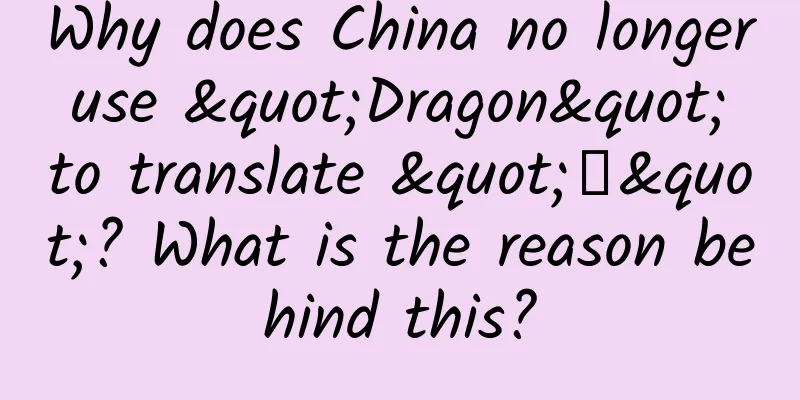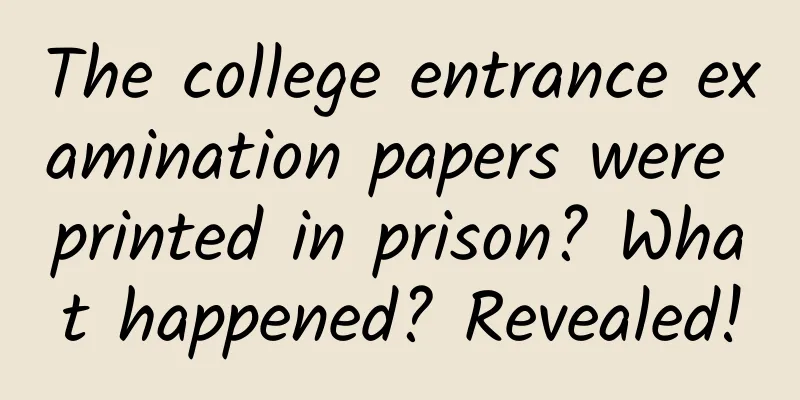Why does China no longer use "Dragon" to translate "龙"? What is the reason behind this?

|
This year is the Year of the Dragon, and a series of topics related to dragons have sparked heated discussions. You may have noticed that in some English expressions, "dragon" is no longer translated as Dragon, but Loong. What is the secret behind this? The dragon is the totem of the Chinese nation and its position in the hearts of the Chinese people is irreplaceable. From the "stone dragon" at the Chahai site 8,000 years ago, to the "clamshell dragon" at the Xishuipo site 6,000 years ago, the jade dragon of the Hongshan culture 5,000 years ago, to the "turquoise dragon" at the Erlitou site 3,600 years ago... since ancient times, "dragons" have been everywhere in China. From ancient times to the Qin and Han Dynasties, the image of the "Chinese dragon" has gradually taken shape, integrated into the cultural bloodline, and deeply rooted in the world and people's hearts. It symbolizes auspiciousness, prosperity, justice and strength, and has the beautiful meaning of being vigorous, energetic, and vigorous. However, the "Dragon" in Western historical legends is a completely negative image. For example, in the Bible, the "Dragon" appears as the incarnation of Satan, the greatest enemy of Christianity. It is evil and hostile to humans, so killing a "Dragon" is regarded as a heroic and brave act, and a symbol of human conquest of nature. This “dragon” (Dragon) is not my “dragon” (Loong). The two are very different in appearance, habits, connotation and extension. For example, a dragon has a horse head, eagle claws, fish scales, deer horns, a snake body and no wings, while a "Dragon" spits out flames, has huge wings and scales, and is as fierce as fire; a dragon does not eat human food, but a "Dragon" eats humans and animals, etc. It is a mistake to equate these two images. According to expert analysis, there are three key figures in the translation process: The first one is Marco Polo. The word "Dragon" appeared in his "Travels to the East". It is speculated that he believed that the dragon on Chinese architecture has certain similarities with the Western "Dragon" from the perspective of appearance. The second person is the British missionary Mashman. In 1809, when he translated the Analects, he annotated the basic Chinese characters used in the translation, and the pronunciation of "dragon" was "Loong". But he still used the word "Dragon" when explaining it later. The third person is the British missionary Robert Morrison. In the first Chinese-English dictionary he edited, he translated dragon into "Dragon". Because the influence of this Chinese-English dictionary was very far-reaching, the word "Dragon" has been used ever since. In this regard, although there are people who say that there is no need to be too fussy about the name; basically the mainstream opinion is that when it comes to cultural definition and discourse power, we must be "meticulous" and get to the bottom of it. In fact, in recent years, some fields have already begun to use the translation method of "Loong". The English name of China's first computer CPU chip "Loongson" is called "Loongson"; the English name of kung fu superstar Bruce Lee is translated as "Lee Siu Loong"; the English title of the movie "The War of Loong" is "The War of Loong"... In fact, heated discussions about "dragon" have occurred many times. It is said that when selecting the mascot for the 2008 Beijing Olympic Games, the reason why the most popular "dragon" was not chosen was because of the concern that the English translation of "dragon" "Dragon" might be misinterpreted. The reason why a word can be "mellow to one, poison to another" is due to both translation reasons and political issues. On the one hand, it is easy to translate words, but difficult to translate culture. It is very difficult to translate the Chinese word "dragon", which is well-known to every Chinese, into the West where there is no corresponding word. This requires a high level of Chinese proficiency, humanistic qualities, and historical perspective of the translator, so translation is also called deep cross-cultural communication. For a core word in Chinese culture like "dragon" - carrying thousands of years of cultural connotations, it is destined to be untranslatable. In high-context Chinese culture, there are countless examples of this, such as "qi" and "kung fu". Therefore, in the encoding-decoding process, some "only understandable, not expressible" content will inevitably produce some "losses" or even deviations. On the other hand, the importance of the "dragon" determines that it must have both cultural and political attributes. In the long-term process of cultural collision and exchange, the two "different dragons with different images and meanings" were deliberately confused, which was nothing more than cultural prejudice or malicious smearing and damaging China's image. In the long run, rumors will spread and a considerable number of foreigners will be misled. Therefore, every process of "hot discussion" is also a process of dialogue and rectification. Whether in media reports or in comments, it is not difficult to find that when the "Dragon" or "Loong" issue appears again in the public opinion field, people's positions have changed from a variety of opinions to a gradual convergence. In my opinion, this precisely reflects that the truth becomes clearer the more it is debated and the truth becomes clearer the more it is explained. According to previous theories and practices, the translation strategy of "transliteration + explanatory translation" is more feasible and has gradually been accepted by most people and has become a social consensus. Compared with "Long", "Loong" even has the charm of pictographic characters, because "oo" is similar to the two eyes of a dragon, so it is better in the minds of many people. From a deeper perspective, this is a vivid microcosm of Chinese culture going global, reflecting the change in the mentality and perspective of the Chinese people. First, they have become more culturally confident. Wanting the world to have a more comprehensive and in-depth understanding of the story of the Chinese dragon and the spiritual power behind it is actually a manifestation of cultural confidence. Second, they have become more level-headed about the world. More and more netizens have begun to face up to the differences between Chinese and Western cultures, strengthen their awareness of external communication, and join in shaping a credible, lovable, approachable, and respectable image of China. This is also a reflection of cultural subjectivity. Recognizing and consolidating this cultural subjectivity can better draw nourishment and wisdom from the excellent traditional culture formed and accumulated by the Chinese nation from generation to generation, so as to tell Chinese stories well and show Chinese style. If the dragon totem is the precious treasure left to us by our ancestors, then how to tell the story of the dragon well is the contemporary issue left to us today. How can external communication be both physical and spiritual, integrating China and the rest of the world? There are many successful explorations worth learning from. A large number of new concepts and expressions that integrate Chinese and English, such as "add oil", "long time no see", "Taikonaut", and "Bing Dwen Dwen", are more fully and vividly showing the Chinese story and the spiritual power behind it, allowing people from all countries to have a more accurate understanding of China and enhance their understanding and appreciation of Chinese civilization. According to data reported by the Global Language Monitor, Chinese English has contributed 5% to 20% of the vocabulary added to international English since 1994, more than any other source. Today, Chinese dragon culture still has strong vitality, and we must also actively transform and develop it creatively to pass on this traditional culture from generation to generation. While maintaining the spiritual core, we must innovate packaging and expression methods, comprehensively consider the communication objects and purposes, and make more Chinese cultural concepts and expressions understood by the outside world, avoiding falling into the situation of "talking to ourselves". At the same time, as the famous British cultural scholar Stuart Hall said, "Cultural identity is both 'becoming' and 'being', belonging to both the future and the past." Therefore, we must handle the relationship between the past and the present well so that Chinese dragon culture can continue to shine in various new scenarios and new trends. Today, China's interactions, exchanges and integration with other countries in the world are unprecedented, and the international community has unprecedented expectations for China's voice and solutions. This requires us to continue to work hard and innovate in building international communication capabilities, so that China's confident roar can pass through the "Tower of Babel" and receive more applause on the world stage. |
<<: Digital Global: How should 5G intelligence empower thousands of industries?
>>: The moon is the most familiar and mysterious object. How should ordinary people observe it?
Recommend
Apple Pay disrupts the payment industry?
A recent market research report shows that Apple ...
Bidding personnel visit homes to analyze competitors? How to write a competitor analysis?
For bidders, in addition to daily data analysis, ...
How to establish a complete user growth system?
The Internet has entered the second half of its e...
Short video operation: How to become a "profitable" vlog blogger?
Tik Tok has been in its fourth year and its produ...
360 search promotion, 360 promotion account opening
As a search engine bidding promotion media, 360 S...
Which is bigger, 9/11 or 9/9? A question that a kindergarten kid can answer stumps a bunch of AIs…
Which one is bigger, 9.11 or 9.9? This question, ...
How to do KOL marketing promotion? 4000 words of dry goods presented
With the rise of short video platforms such as Ti...
BMW 7 Series flagship model priced over $150,000 announced
Recently, BMW officially announced the price of t...
Tik Tok operation plan and strategy skills
The popularity of Douyin is unquestionable, so ho...
If you sit for a long time all day and lack exercise, you should be careful...this disease has already targeted young people!
《Cotton Swab Medical Science Popularization》 Mi Y...
The "Money Tree" Really Exists! Learn the Growth Secrets of This 1,800-Year-Old "Sacred Tree"
Guo Kai Liu Yujiao Speaking of money trees, you m...
China, a karst country
Karst landforms are widely distributed in the wor...
The memory of a generation! Some WeChat emoticons disappeared silently
On December 2, the topic "These WeChat emoti...
Interface return code and alarm troubleshooting global return code
Each time the official account calls an interface...









